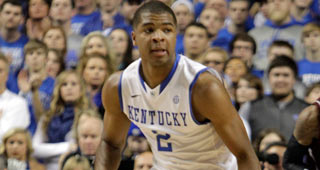With the deadline to declare for the 2014 NBA Draft behind us, our look at the top prospects coming back to school at each position continues with the shooting guards. The big thing for most players at the position is opportunity - there are only so many touches and so many shots to go around in an offense. Ideally, an NBA prospect at the SG position can dominate the ball for at least one season, in order to give scouts an idea of how complete they are as an offensive player.
That’s how you make your money in the draft - Nik Stauskas went from a spot-up shooter (and a second-round prospect) to the Big Ten Player of the Year (and possible lottery pick) when he moved into a bigger role at Michigan following the departures of Trey Burke and Tim Hardaway Jr. Of course, not every player will respond well to such an opportunity. Glenn Robinson III lost a ton of money when he wasn’t able to make a similar leap in his sophomore season.
There is no shortage of big, athletic guards who can shoot the ball - what separates the best SG prospects is the ability to attack the rim and create shots for their teammates. This is the most important summer of most of these player’s careers. If they can’t prove they can handle the extra responsibility, they will become yesterday’s news as a new wave of SG’s comes up behind them. The margin for error for a 6’5+ wing prospect isn’t all that high.
Wayne Selden, Kansas - After playing in the shadow of Andrew Wiggins and Joel Embiid as a freshman, Selden will be given the keys to the Kansas offense as a sophomore. At 6’5 230, he’s a good athlete with excellent size for a SG and his strength should allow him to double as a SF at the next level. Selden had to adjust to playing off the ball last season, but he showed promise as a scorer, shooter and passer. If he can improve his shooting percentages while maintaining a positive assist-to-turnover ratio, he should be in the lottery discussion.
Caris Levert, Michigan - With the departures of Stauskas, Robinson and Mitch McGary to the NBA, a lot will be expected of Levert headed into his junior season. At 6’6 220 with the ability to shoot 3’s, put the ball on the floor and create shots for others, Levert has all the tools to make a Stauskas-like leap as the primary option in John Beilein’s system. He’s faster and more solidly built than Stauskas and he’s almost as good a shooter, so I wouldn’t be shocked if he ends up as the better NBA player.
Jabari Bird, Cal - A 6’6 180 athlete with good ball-handling and shooting ability, Bird has all the tools to be an NBA SG. With Justin Cobbs graduated, he should have a much bigger role in the Cal offense next season, although the transition from an offensive minded coach in Mike Montgomery to a defensive-minded coach ni Cuonzo Martin could take some getting used too. If Bird can play up to his potential and grown into a role as a first option at Cal, he should make Martin’s new life on the West Coast a little easier.
Jordan Richardson, Tennessee - With Jordan McRae and Jeronne Maymon graduating, Jarnell Stokes declaring for the NBA Draft and Cuonzo Martin off to Cal, Richardson is the one of the only players left from Tennessee’s unlikely run to the Sweet 16. At 6’6 200, Richardson is an elite athlete with the potential to be a defensive stopper on the next level. His discovery of a three-point shot last season is what allowed the Volunteers to make a run - he will have to start creating his own shot for them to stay near the top of the SEC.
Keith Frazier, SMU - As the first McDonald’s All-American to come to SMU in a generation, there were a lot of expectations on Frazier headed into his freshman season. An electric athlete at 6’5 190 with the ability to score from anywhere on the floor, he definitely has the tools to play in the NBA, but he spent most of the season playing like a poor man’s Gerald Green. If Larry Brown can get him playing within himself as a sophomore, he could team up with Emmanuel Mudiay to push the Mustangs program to previously unforseen heights.
Other names to watch:
Jerian Grant (Notre Dame), Michael Frazier II (Florida), Aaron Harrison (Kentucky), Dez Wells (Maryland)



